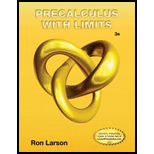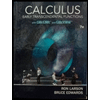
Concept explainers
To write : the polynomial as the product of linear factors and list all the zeros of function
Answer to Problem 65E
The function as product of linear factors: h(x)=(x−1−4i)(x−1+4i)
The zeros of the function are: x=1+4i ; 1−4i
Explanation of Solution
Given information:
h(x)=x2−2x+17
Concept Involved:
Linear Factorization Theorem:If f(x) is a polynomial of degree n , where n>0 , then f(x) has precisely n linearfactors f(x) = an(x − c1)(x − c2). . . (x − cn) where c1, c2, . . . , cn are complex numbers.
Complex Zeros Occur in Conjugate Pairs: Let f be a polynomial function that has real coefficients. If a+bi , where b≠0 , is a zero of the function, then the complex conjugates a−bi is alsoa zero of the function.
Calculation:
To find the zeros of the function we need to set the function to zero h(x)=0
x2−2x+17=0
We can solve this equation using completing the square method by subtracting17 on both sides of the equation
x2−2x+17−17=0−17
Simplify on both sides of the equation
x2−2x=−17
In order to make the left side expression as perfect square trinomial, we need to add square of half of coefficient of x on both sides
x2−2x+1=−17+1
Simplify on right side of the equation
x2−2x+1=−16
Write the left side as a perfect square
(x−1)2=−16
Take square root on both sides
√(x−1)2=√−16
Split the number in the right side of the equation
√(x−1)2=√−1⋅√16
Simplifying square root on both sides of the equation
x−1 =√−1⋅±4
Replace i for √−1
x−1=±4i
Add 1 on both sides of the equation
x−1+1=1±4i
Simplify in left side of the equation
x=1±4i
List the zeros of the functions given:
x=1+4i ; x=1−4i
If x=k is zero, then x−k will be the factor of the function.
So x−(1+4i) & x−(1−4i) are the factors of the function
Write the function h(x)=x2−2x+17 as product of linear factors:
h(x)=(x−1−4i)(x−1+4i)
Conclusion:
The zeros of the given function h(x)=x2−2x+17 are: x=1+4i ; 1−4i
The function written as product of linear factors: h(x)=(x−1−4i)(x−1+4i)
Chapter 2 Solutions
Precalculus with Limits
- quick solve thisarrow_forwardquick solve thisarrow_forwardThis table displays the current in equal intervals. Time t/ms 05 10 15 20 25 30 Current i/A 0 4.8 9.1 12.7 8.8 3.5 0 The formula for the charge as follows: 30x10-3 q 0 i dt Use formula to solve the current at 30ms using both the trapezoidal rule and Simpson's rule showing all steps and workingarrow_forward
 Calculus: Early TranscendentalsCalculusISBN:9781285741550Author:James StewartPublisher:Cengage Learning
Calculus: Early TranscendentalsCalculusISBN:9781285741550Author:James StewartPublisher:Cengage Learning Thomas' Calculus (14th Edition)CalculusISBN:9780134438986Author:Joel R. Hass, Christopher E. Heil, Maurice D. WeirPublisher:PEARSON
Thomas' Calculus (14th Edition)CalculusISBN:9780134438986Author:Joel R. Hass, Christopher E. Heil, Maurice D. WeirPublisher:PEARSON Calculus: Early Transcendentals (3rd Edition)CalculusISBN:9780134763644Author:William L. Briggs, Lyle Cochran, Bernard Gillett, Eric SchulzPublisher:PEARSON
Calculus: Early Transcendentals (3rd Edition)CalculusISBN:9780134763644Author:William L. Briggs, Lyle Cochran, Bernard Gillett, Eric SchulzPublisher:PEARSON Calculus: Early TranscendentalsCalculusISBN:9781319050740Author:Jon Rogawski, Colin Adams, Robert FranzosaPublisher:W. H. Freeman
Calculus: Early TranscendentalsCalculusISBN:9781319050740Author:Jon Rogawski, Colin Adams, Robert FranzosaPublisher:W. H. Freeman
 Calculus: Early Transcendental FunctionsCalculusISBN:9781337552516Author:Ron Larson, Bruce H. EdwardsPublisher:Cengage Learning
Calculus: Early Transcendental FunctionsCalculusISBN:9781337552516Author:Ron Larson, Bruce H. EdwardsPublisher:Cengage Learning





